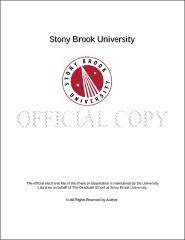| dc.identifier.uri | http://hdl.handle.net/11401/76375 | |
| dc.description.sponsorship | This work is sponsored by the Stony Brook University Graduate School in compliance with the requirements for completion of degree. | en_US |
| dc.format | Monograph | |
| dc.format.medium | Electronic Resource | en_US |
| dc.language.iso | en_US | |
| dc.publisher | The Graduate School, Stony Brook University: Stony Brook, NY. | |
| dc.type | Thesis | |
| dcterms.abstract | Zinc oxide (ZnO) has been well known as a transparent, dielectric, piezoelectric and wide band gap material. The potential capabilities have been demonstrated for a wide range of applications such as piezoelectric transducer, gas sensor, optical waveguides and transparent electrode. It could also be applied as a substrate material for GaN-based devices. However, while some applications have already been realized, issues relating to crystalline defects remain a barrier to the successful realization of several others. In this thesis, the central focus of Chapter II is to characterize threading dislocations in hydrothermal grown ZnO substrates through simulation work as well as other techniques. The goal of this study is to find the origin of threading dislocations and design strategies to mitigate their negative effects by either reducing their densities or completely eliminating them. In Chapter III, the technique of SMART (stress mapping analysis via ray tracing) is discussed in detail to measure residue stress in packaged silicon circuits. Residual stress plays an important role in the performance and lifetime of single crystal device material. There are mainly two advantages of SMART compared with other techniques: (a) all six components of the stress tensor could be evaluated; (b) it is non-destructive and no damaging trace will be left on the sample. In this study, our goal is to build a relationship between stress distribution and depth. The concept of penetration depth is critically important in this study and its value may cause great changes for real space stress distribution. A new function is applied to get better fitting curves. Data in this study is obtained from various penetration depth, which represents exponentially decaying weighted average of actual stress value or in other words this stress profile is Laplace transform of real stress profile. Mathematical procedure is described to determine real stress profile from Laplace profile. Experiment procedure, detailed penetration depth calculation, accurate positioning of film and sample and error analysis is introduced in this study. | |
| dcterms.available | 2017-09-20T16:50:08Z | |
| dcterms.contributor | Raghothamachar, Balaji | en_US |
| dcterms.contributor | Dudley, Michael | en_US |
| dcterms.contributor | Venkatesh, T. A.. | en_US |
| dcterms.creator | Zhou, Tianyi | |
| dcterms.dateAccepted | 2017-09-20T16:50:08Z | |
| dcterms.dateSubmitted | 2017-09-20T16:50:08Z | |
| dcterms.description | Department of Materials Science and Engineering. | en_US |
| dcterms.extent | 73 pg. | en_US |
| dcterms.format | Monograph | |
| dcterms.format | Application/PDF | en_US |
| dcterms.identifier | http://hdl.handle.net/11401/76375 | |
| dcterms.issued | 2013-12-01 | |
| dcterms.language | en_US | |
| dcterms.provenance | Made available in DSpace on 2017-09-20T16:50:08Z (GMT). No. of bitstreams: 1
Zhou_grad.sunysb_0771M_11410.pdf: 3587571 bytes, checksum: d46cdc89a4db99850c4663f049f4d117 (MD5)
Previous issue date: 1 | en |
| dcterms.publisher | The Graduate School, Stony Brook University: Stony Brook, NY. | |
| dcterms.subject | Materials Science | |
| dcterms.subject | characterization, ray tracing, stress distribution, threading dislocation | |
| dcterms.title | Threading Dislocation Characterization and Stress Mapping Depth Profiling via Ray Tracing Technique | |
| dcterms.type | Thesis | |

